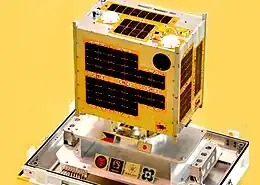| Mission type | Earth observation |
|---|---|
| Spacecraft properties | |
| Manufacturer | Department of Science and Technology (Philippines) University of the Philippines Philippine Space Agency |
| Launch mass | 130 kg (290 lb) |
| Start of mission | |
| Launch date | 2025 (planned) |
| Orbital parameters | |
| Regime | Low Earth |
| Instruments | |
| TrueColour Camera Automatic Identification System Automatic Dependent Surveillance-Broadcast | |
| Advanced Satellite and Know-how Transfer for the Philippines | |
The Multispectral Unit for Land Assessment (MULA) is a planned Filipino satellite. Upon completion it will become the largest Filipino-made satellite.
Development
The Philippine Space Agency (PhilSa) announced on June 9, 2021, that a satellite is in development that would be bigger than the ones made previously under the Philippine Scientific Earth Observation Microsatellite (PHL-Microsat) program. The satellite is named Multispectral Unit for Land Assessment (MULA).[1] MULA would be the first of a "next-generation satellites" under the Philippine space program, with the team behind the satellite building on the knowledge gained in developing the Diwata and Maya nanosatellites.[2] The investment cost for the satellite is at least US$34 million.[3]
The satellite project is led by John Leur Labrador and is part of the Advanced Satellite and Know-how Transfer for the Philippines (ASP) of the Department of Science and Technology (DOST). The University of the Philippines Diliman and DOST-Advanced Science and Technology Institute, in coordination of PhilSa, are the lead entities responsible for MULA's development. It is also co-designed with British firm Surrey Satellite Technology.[4] Filipino engineers who worked on MULA were sent to the United Kingdom for an immersion on satellite design and manufacturing process.[3]
The preliminary mission objectives of MULA was determined in early 2020.[5]
Instruments
MULA will weigh 130 kg (290 lb), and will become the largest Filipino-made satellite.[6] It is equipped with a TrueColour camera which has a capability to capture images with a 5 m (16 ft) resolution and a wide swatch width of 120 km (75 mi). MULA will also have nine spectral bands for various environmental applications including land cove change maping, crop monitoring, and disaster and forestry management.[4] It will be designed to be able to take images of roughly 100,000 km2 (39,000 sq mi) of land area daily.[7]
It will also be equipped with Automatic Identification System (AIS) and Automatic Dependent Surveillance–Broadcast (ADS–B) which could be used to detect and track aircraft and ships.[5] The satellite will also have a jet propulsion system.[3]
Launch and mission
It was planned that MULA would be launched to space by 2023[5] but this schedule has been postponed to 2025.[8] MULA will be positioned in low Earth orbit, and will rotate around the globe ten times daily.[3]
References
- ↑ Gonzales, Gelo (June 9, 2021). "Biggest PH satellite yet, MULA, in development for wider area monitoring". Rappler. Retrieved June 11, 2021.
- ↑ Cruz, Kaithreen (June 10, 2021). "PH to launch bigger satellite in 2023". Manila Times. Retrieved June 11, 2021.
- 1 2 3 4 Arayata, Maria Cristina (August 18, 2021). "PhilSA exec notes importance of building satellites". Philippine News Agency. Retrieved August 26, 2021.
- 1 2 Viernes, Franchesca (June 10, 2021). "PHL's biggest satellite MULA now in development, to be used for environmental monitoring". GMA News. Retrieved June 11, 2021.
- 1 2 3 Hernando-Malipot, Merlina (June 10, 2021). "Our own 'astronaut' in space? PH eyes having new Earth Observation satellite in space by 2023". Manila Bulletin. Retrieved June 11, 2021.
- ↑ Cabalza, Dexter (June 13, 2021). "PH to launch biggest satellite in 2023". Philippine Daily Inquirer. Retrieved June 13, 2021.
- ↑ Ferreras, Vince (June 10, 2021). "PH eyes launch of 'bigger' Earth observation satellite by 2023". CNN Philippines. Retrieved June 11, 2021.
- ↑ "PH to launch biggest locally developed satellite in 2025". CNN Philippines. October 20, 2022. Retrieved October 21, 2022.
.jpg.webp)
